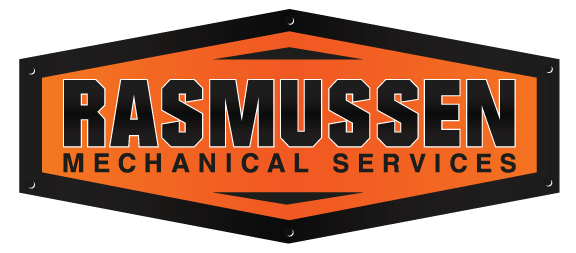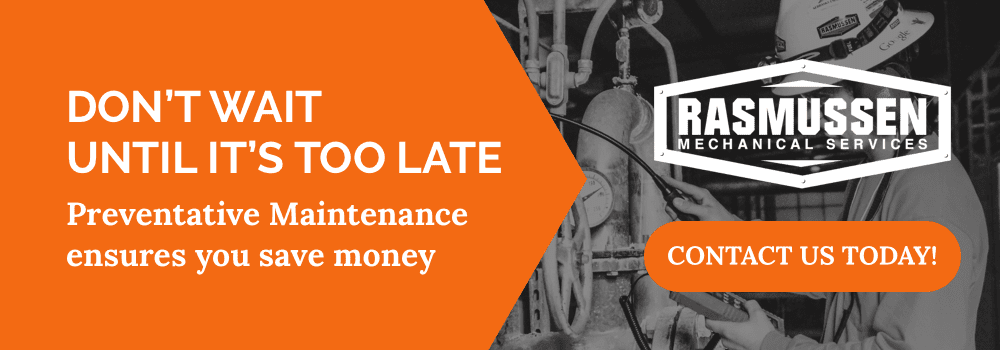Industrial shutdowns are one of the most impactful events in the routine operation of your plant. While an industrial shutdown may sound like a simple process, there are many factors that are often forgotten. Rasmussen Mechanical Services is here to ensure your next one goes off without a hitch.
When a shutdown goes poorly, lasts too long, or exceeds the budget, it will have a negative impact on your facility. Unfortunately, this often shows in your bottom line. However, when shutdowns go well, there are a number of benefits for your operations. These benefits include being able to thoroughly inspect systems, complete routine maintenance, and replace old or worn equipment – things you may not be able to do while your facility is operating. Plus, a properly executed shutdown will have a significant impact on the efficiency and safety of your plant, while also setting your company up for long-term prosperity.
Plant #shutdowns are expensive but can save you thousands in the long run. Discover how in @RasMech’s latest: Click To TweetIndustrial Shutdowns, Simplified.
Simply put, a shutdown is a time where production halts within the plant. Day-to-day operations pause and instead, the focus shifts to maintenance-related activities like cleaning, inspecting, and repairing equipment. Some shutdowns also incorporate process improvement activities that will have a positive impact on overall plant efficiency.
There are a few different types of shutdowns that your plant may undergo:
- Planned Shutdowns – Planned industrial shutdowns are scheduled well in advance to allow for proper shutdown arrangements. The maintenance crew will have a thorough list of tasks to complete that are next to impossible during daily operations. This downtime is preplanned and allows the team to work through the issues that have come up since the last shutdown in a timely and efficient manner.
- Emergency Shutdowns – Emergency shutdowns are when a facility halts operations at a moment’s notice. This most often occurs when equipment fails. Although unplanned and often frustrating, if protocols are in place, the emergency shutdown should happen quickly and in a controlled manner. This, in turn, will reduce the risk of accidents during the chaos.
- Partial Shutdowns – Partial shutdowns allow part of a plant to remain operational in some capacity. These often accompany emergency shutdowns and can present additional challenges for startup and product quality.
- Full Shutdowns – Full shutdown means an absolute halt to day-to-day operations. These are often planned shutdowns with a thorough list of tasks to complete.
During an industrial shutdown, the plant’s employees and outside contractors work quickly to get the plant ready to return to its regular operations. Preparation is of the essence when it comes to shutdowns as they can quickly become expensive in terms of production loss, increased labor, and equipment expenses. A planned shutdown can reduce operating expenses budgets through the processes of planning, executing, and analyzing.
Planning an Industrial Shutdown.
This is the phase in which one determines the overview of the operation. Discuss the intricate details of the shutdown, evaluate equipment replacements, upgrades, or repairs, and select contractors.
The facility’s internal team, the head contractor for the project, and any other key stakeholders determine the scope of work. The budget and the schedule will be negotiated between these key members. Safety concerns for the work being performed should also be evaluated during this time to prevent dangerous and unplanned situations. When this work has been completed, compile industrial shutdown tasks, and assign specific individuals involved in the shutdown.
Vetting resources, defining the scope, and compiling tasks take time, so the planning phase should be expected to take anywhere from one to three months. To help expedite the process, follow these tips:
- Review lessons learned from previous shutdowns to establish best-practices and avoid repeating mistakes.
- Designate an ultimate decision-maker to mitigate the risk of the budget and schedule overrun due to scope creep.
- Establish a contingency plan and create a contract that explains how to share savings between the owner and the contractor.
- Be diligent about communication, including detailed instruction and oversight for novices, as well as a notice of restricted areas that will be open only to certain levels of personnel.
[Shutdowns don’t have to be a headache. Download our ebook, Tips for Facility Managers: Managing a Successful Plant Shutdown, to guide you through a safe and successful industrial shutdown.]
Executing an Industrial Shutdown.
The execution stage involves putting your plans into action and completing the shutdown as safely, quickly, and efficiently as possible.
To ensure critical stakeholders know what is going on, start each day with a “plan, do, review, and adjust” meeting. Discuss the plan for the day and what each member is to do to ensure that the plan is seen through. Review what is and is not on track and how the team should adjust to make up for that lost time. Also, chat about what additional resources may be needed, and any potential risks that need to be managed. Taking ten minutes out of your teams’ morning for this meeting will allow for a more efficient workday.
Provide day-to-day oversight and supervision of contractors based on the criticality of what they are doing. This also includes verification of completion.
Make sure cleaning accompanies every major activity, so contamination doesn’t occur, and waste isn’t allowed to build up. Our experts suggest picking up as you go, or to pick up before clocking out for the day.
Analyzing an Industrial Shutdown.
The final stage involves analyzing the processes that took place during the shutdown. Good practice includes creating a report of your findings and lessons learned. Within this report, include items like:
- What went well?
- What didn’t go well?
- What improvements can be made next time?
- A summary of risks and how they were managed or contained.
- A completed checklist covering all executed activities.
By analyzing your project at the time of completion, you’ll be able to account for all of the nitty-gritty details that went into it. Plus, you’ll have a fair assessment of each of the questions above.
Pull this report out the next time that your team begins the planning stage of a shutdown so that you can review. Explain to your team what went into the success of this industrial shutdown and how you’ll be able to replicate that for this next shutdown. Also, discuss the failures and how you’ll be able to mitigate those during the upcoming shutdown. By taking the time to complete this analysis, your future shutdowns will be more successful.
Why Shutdown?
There are a number of often-overlooked advantages a shutdown can have for your plant. For example, this process provides a prime opportunity to resolve various maintenance issues that have been pushed off or forgotten. This is a vital opportunity to have the components of your mechanical equipment inspected by professionals, as it is often impossible to do while your plant is in operation. This process of preventative maintenance serves your plant with an increase in efficiency, while also saving you money on costly reactive repairs.
In addition, shutdowns offer an ideal time for major system renovations or overhauls to occur. An industrial shutdown should result in the plant returning to peak performance, and function at optimal efficiency until the next shutdown. Many times, equipment or system improvements can be easily and affordably implemented, resulting in increased plant performance following the shutdown. However, if you do plan to piggyback scheduled maintenance with the shutdown, make sure these routine tasks are communicated during the planning stage so they do not compromise the shutdown schedule and budget.
Have you ever shut down your plant for #PreventativeMaintenance? Learn the crucial long-term impact of a shutdown from @RasMech: Click To TweetWe’re All In This Together.
While shutting down your plant for any period of time may sound like a frightening and costly venture, there’s no need to worry. Shutdowns typically utilize various third-party maintenance service providers, like the experts at Rasmussen Mechanical Services. The value added by their involvement is tenfold because knowledgeable contractors reduce shutdown length while maximizing plant efficiency. Furthermore, a good contractor is a specialist in equipment and can provide valuable insight and recommendations to improve the reliability and efficiency of your plant.
To get the most out of your contractors, work together in the planning stage. For starters, ensure contractors have a clearly defined scope of work and prepare equipment and materials for any contingencies that may arise. Layout the safety requirements for your shutdown early to avoid confusion, delays, and tension during the shutdown. Know who is providing lifts, air monitors, hole watches, and other safety equipment and services throughout the shutdown. You will want to know about any systems the contractor intends to lockout and any areas the contractor intends to barricade for hot work or critical lifts.
Everyone involved in the shutdown should represent a key aspect of at least one vital role or responsibility. It is crucial that each person involved is well-trained in their role and safety procedures and has a clearly defined role in the shutdown process and any emergency response procedures.
Key Takeaway
The important thing to remember during an industrial shutdown is that while they appear expensive and disruptive on the surface, they are vital to the long-term efficiency and success of your plant. By completing this procedure, you’ll provide a crucial opportunity to focus on needed maintenance tasks that would otherwise go untouched. Shutdowns also provide the opportunity to install upgrades to make your plant run more reliably and efficiently. When done right, shutdowns prove to be an essential component of your plant’s longevity and can increase profit margins going forward.
Contact Rasmussen Mechanical Services today to discuss the many ways we can partner with you in the planning, execution, and analyses of a safe and productive industrial shutdown.
This article was originally published on February 20, 2018. This was updated on December 23, 2019.



